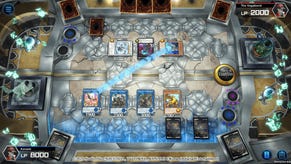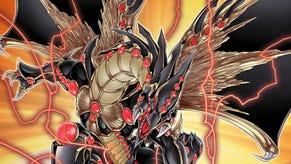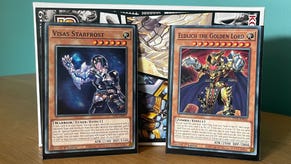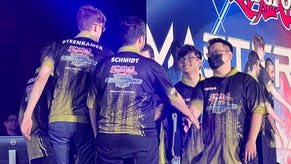5 classic Yu-Gi-Oh! formats that changed the TCG
Frogs, DADs and GOATs, oh my!
While players may have an all-time favourite or powerful card they remember fondly from their time playing the Yu-Gi-Oh! TCG, no card can be powerful on its own. When players look back on the two-plus decade history of the trading card game, people remember not just the cards they liked, but the decks and competitive Yu-Gi-Oh! formats that defined the trajectory of the game, for better and for worse.
Yu-Gi-Oh! formats
A format in Yu-Gi-Oh! refers to a particular era in the history of this most auspicious of trading card games, typically defined by the decks that dominated and separated by the release of new sets or a ban list that changed the direction of competitive play. Here, we want to highlight a few of those from throughout the history of the game and why they remain so memorable. Whether that be for beloved decks, surprising variety or all-consuming dominance, these are the Yu-Gi-Oh! formats from years past that still get spoken of today.
Considering the recency bias that could come into play here, more modern formats from the past few years won’t take a place on this list. Many of these periods in the history of Yu-Gi-Oh! were mostly beloved in retrospect for how they offered a balance or unique playstyle that hasn’t been replicated elsewhere. We’ll have to see if modern formats similarly stand to this test of time.
1. Chaos Control
Ironically, the end of Chaos

What makes Chaos Control so memorable is how it signalled an evolution in the early years of Yu-Gi-Oh!’s existence as a card game in English. With a small card pool and a player base more influenced by the anime, and younger than almost any period since, the typical entrants to a Yu-Gi-Oh! tournament were younger and archetype- or strategy-driven decks weren’t dominant. Beatdown decks with powerful monsters like Summoned Skull, fan favourites and powerful game-changers like Heavy Storm and Dark Hole were the name of the game.
Thanks to a larger competitive scene and larger pool of cards from the release of a greater number of sets, Chaos Control was the moment where certain strategies and archetypes and decks began to rise to the surface. Jinzo’s powerful effect to negate traps made him a staple in many beatdown decks that continued to exist, but few could handle the strength of Chaos Control.
It’s difficult to argue that Chaos Control wasn’t simply a more advanced variant of the beatdown decks of before, yet the focus to buff the deck with predominantly Light and Dark monsters gave it access to Chaos monsters like Black Luster Soldier - Envoy of the Beginning and Chaos Emperor Dragon - Envoy of the End. Their effects to allow multiple attacks and easy clears of bothersome monsters - in the case of Black Luster Soldier - and hand destruction with burn damage opened the door to near-instant victory the moment these hit the field.
Chaos Control was memorable for how it signalled a shift towards greater strategy and the existence of defined formats seen in the modern game. So powerful was this deck in the early days of Yu-Gi-Oh!, in fact, that many cards from it, such as D.D. Warrior Lady, continued to influence the format for years.
2. GOAT Format
For many, GOAT is the GOAT

Spend enough time around other Yu-Gi-Oh! players, and GOAT Format is going to be mentioned. This era was defined by GOAT Control and named as such due to the importance of Scapegoat and its field-swarming Sheep Tokens. These tokens were used to summon monsters like Thousand-Eyes Restrict (with the help of the now-banned and likely never-to-return Metamorphosis that allowed you to tribute any monster of equivalent level to Fusion summon), a defining card of this era for its ability to, well, restrict what your opponent could do. With Thousand-Eyes Restrict on the field, the ability to equip your opponent’s most powerful monster to this card while preventing them from attacking made them difficult to overcome, even ignoring the protection to your own life points from the unused tokens.
GOAT Format isn’t merely beloved by those who played GOAT Control when the deck was at its most powerful. Thanks to the prior banning of cards like Chaos Emperor Dragon - Envoy of the End the format had slowed down, and space was opened for decks with direct counters to GOAT Control taking advantage of Book of Moon and similar flip effects, Zombies, Machines and more holding their own in the competition.
One of the slowest competitive formats, yet still one of the most varied and engaging, some players still enjoy returning to this period of the game to play retro decks harkening back to this era. For those who experienced it, it remains a strong favourite.
3. DAD Format
A Father’s Day gift like no other

No, this wasn’t a format specifically for older players with children, but it’s a nice thought. Dark Armed Dragon, unleashed onto the TCG in early 2008 in the Phantom Darkness set, became a key card in a number of powerful decks and endured over numerous ban lists.
Using Destiny Draw, Allure of Darkness and Destiny Hero Disk Commander as draw power and material expenditure for the deck, Return DAD was the first competitive deck using this card by consistently and quickly acquiring the materials needed to bring Dark Armed Dragon to the field. With its effect to banish a Dark monster from your Graveyard to destroy an opponent’s monster not being limited to once per turn and requiring three Dark monsters in graveyard to summon it, the mass removal and strong 2800 attack made it difficult to overcome. Particularly since, after summoning Dark Armed Dragon, nothing prevents you from sending more Dark monsters to your Graveyard to keep activating its effect.
When Return DAD was eventually hit by ban lists, it merely re-emerged as TeleDAD, adding Krebons and a Destiny Hero engine to enable Synchro plays and address consistency issues. The extended power of DAD came amidst a legal fight for the future of Yu-Gi-Oh! and can be classed as a turbulent time for the TCG, defined by one of the longest-standing top decks to consistently rule it.
4. Frog FTK
I toad you so

Frogs have held an ever-present force in Yu-Gi-Oh since the mid-2000s following the release of Treeborn Frog. Its ability to Special summon itself from the Graveyard during your Standby Phase when controlling no spell or trap cards made it useful tribute fodder in Monarch decks. In 2010, the deck became its most powerful when it resulted in one of the most consistent FTKs (combos that can wipe your opponent's life points in the first turn) ever to exist in the game.
The small-and-steady burn damage of Frog FTK made it a slow but effective way to burn your opponent’s life points to zero before they could even make a move. This deck, crucially, existed at a time before hand traps like Effect Veiler and Ash Blossom & Joyous Spring, making it difficult to counter if you didn’t get to make the first move. Using the continuous spell card Mass Driver, it was possible to use Substitoad and Ronintoadin to create a loop that constantly provided tribute fodder for Mass Driver’s effect to inflict 400 life points of damage, eventually bringing your opponent to zero.
So consistent was the FTK that it won the 2010 World Championships. To eventually stop it, Substitoad was banned, where it remains to this day. Since this format, any potential FTKs have been quickly stamped out by preventative or reactive ban lists.
5. Dragon Ruler vs. Spellbook
The battle of the Titans

Typically, even when you have two decks competing at the top of a particular Yu-Gi-Oh! format, it’s still possible for rogue decks to have an impact and for smaller decks to at least have some impact. In 2013, Dragon Ruler and Spellbook were so powerful that they consumed the entire format, resulting in some of the most radical ban lists to counter their dominance.
Dragon Rulers were among the most consistent, powerful monsters ever to grace the game, able to discard themselves with another monster of the same attribute to search another copy of themselves, fulfilling their own summoning requirements from their own effect. If that wasn’t enough, each of the four Dragon Rulers had a baby version for increased consistency, Super Rejuvenation for incredible end-turn draw power and Xyz options like Mecha Phantom Beast Dracossack to extend their plays.
The only deck really able to compete with this was Spellbook. This was a high-spell card deck powerful primarily thanks to Spellbook of Judgment’s ability to rebuild your hand with strategy-building spell cards and a powerful Spellcaster in the end phase, alongside running monsters directly countering Dragon Rulers like Jowgen the Spiritualist. Telling of its dominance, the banning of Spellbook of Judgment (which stands to this day) was the only thing toppling the deck from the top spot. For Dragon Ruler, even a ban to all baby Dragon Rulers wasn’t enough, requiring all four boss monsters to be banned.
Only Tempest, Dragon Ruler of Storms has been unbanned in the following years, and now sits on the Yu-Gi-Oh! banlist as a card limited to one copy per deck.
In the years since, a number of other memorable Yu-Gi-Oh! formats have come and gone. Many fondly look back on HAT format, an era defined by Hand Artifact Traptrix and Infernity, while others look towards the 2019 format featuring the likes of Thunder Dragon, Sky Striker and Salamangreat, an era defined by the consistency of the decks able to take and retain a place at the top tier of the game.
Each era of Yu-Gi-Oh! discussed here is defined by game-defining twists in how the card game would evolve in the years which followed, or were simply powerful enough to serve as a warning for the future. But they all define where Yu-Gi-Oh! stands today.









